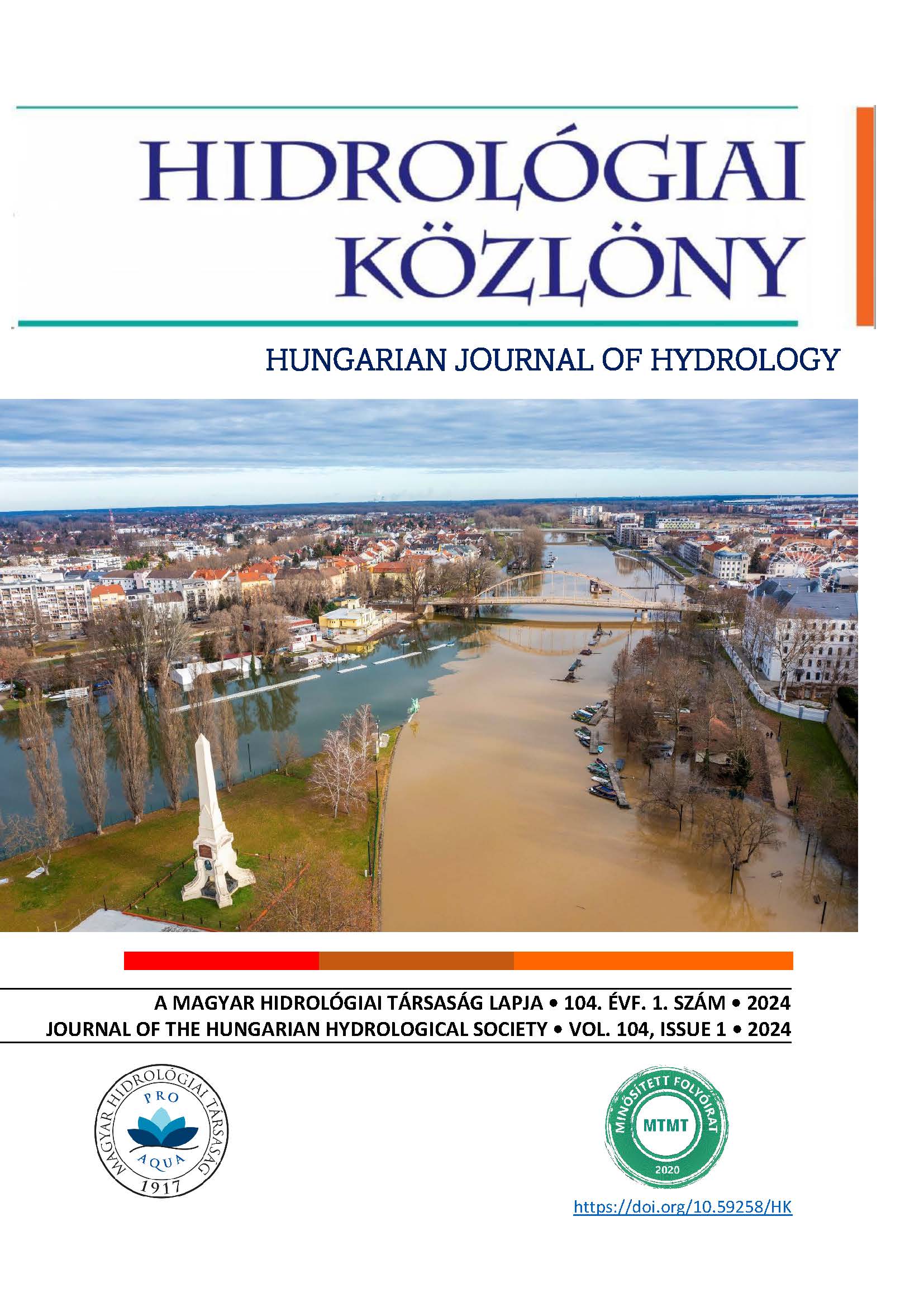1D hydrodynamic modelling on River Tisza: challenges, results, difficulties
Abstract
The Hungarian Hydrological Forecasting Service (HHFS) operating within the framework of the National Water Directorate General has been operating a tailor-made 1 dimensional hydrodynamic model on River Danube since January 2020, while developing the model onto River Tisza, which was completed by the beginning of 2023 as well. The main objective of the development is to support and substitute the already running discrete linear cascade models (DLCM). The model contains the Tisza between Tiszabecs and Novi Bečej and all the Hungarian reaches of the tributaries. Data collection and model building are still in process on the foreign river reaches. The Tisza catchment has a complex hydrology often causing multiple flood peaks simultaneously along the river. The tribu-taries have a highly dynamic regime and all of the subcatchments can release significant discharges at the same time. The natural conditions for flood propagation had been modified due to the hydropower plants thus backwater effect is a major factor at the hy-draulic structures and at the confluences. Modelling such structures requires the substitution of the Saint Venant equations with the basic hydraulic formulas. In this paper I present the building process of the model, the challenges I had to face and the achieved results. The results are then compared to the results of a HEC-RAS based system (Tisza Valley Flood Protection Analysis Center), to the forecasts published by the HHFS, and also to the pure DLCM results. the HHFS.
References
Abbott, M.B. (1979). Computational Hydraulics. Pittman Publishing Limited, Boston. London, Melbourne.
Abbott, M.B., Basco, D.R. (1989). Computational Fluid Dynamics. Longman Scientific & Technical, Harlow.
Bathe, K.J., Wilson, E.L. (1976). Numerical Methods in Finite Element Analysis. Prentice Hall, Upper Saddle River.
Cammalleri C., Naumann G., Mentaschi L., Formetta, G.(a), Forzieri, G., Gosling, S.(b), Bisselink, B., De Roo, A., Feyen, L. (2020). Global warming and drought impacts in the EU, EUR 29956 EN, Publications Office of the European Union, Luxembourg, 2020, ISBN 978-92-76-12947-9. https://data.europa.eu/doi/10.2760/597045
Chang, F.J., Chang, L.C., Chen, J.F. (2023). Artificial Intelligence Techniques in Hydrology and Water Resources Management. Water 2023, 15, 1846. https://doi.org/10.3390/w15101846
Cunge, J.A., Holly, F.M., Verwey, A. (1980). Practical Aspects of Computational River Hydraulics. London: Pitman.
Di Nunno, F., de Marinis, G., Granata, F. (2023). Short-term forecasts of streamflow in the UK based on a novel hybrid artificial intelligence algorithm. Sci Rep 13, 7036 (2023). https://doi.org/10.1038/s41598-023-34316-3
Fread, D.L., Lewis, J.M. (1998). NWS FLDWAV MODEL. NOAA, Hydrologic Research Laboratory, Office of Hydrology.
Kalinin, G.P., Milyukov, P.I. (1957). Raschete neustanovivshego- sya dvizheniya vody v otkrytykh ruslakh. On the computation of un- steady flow in open channels. Met. i Gydrologia Zhurnal, 10, pp.10-18. Leningrad.
Lhotka, O., Trnka, M., Kysely, J., Markonis, Y., Balek, J., Mozny, M. (2020). Atmospheric Circulation as a Factor Contributing to Increasing Drought Severity in Central Europe. JGR Atmospheres, 18. 125. https://doi.org/10.1029/2019JD032269
Liptay Z.Á., Gauzer, B. (2021). Operational river ice and water temperature forecasting on the Hungarian Danube reach, In: Science and practice for an uncertain future. https://doi.org/10.3311/FloodRisk2020.17.11
Liptay Z.Á. (2022). Neurohydrological prediction of water temperature and runoff time series. Acta Hydrologica Slovaca. 23. pp. 190-196. https://doi.org/10.31577/ahs-2022-0023.02.0021
Nash, J.E. (1960). A unit hydrograph study, with particular reference to british catchments. Hydraulics Research Station, Department of Scientific and Industrial Research, p. 6433. https://doi.org/10.1680/iicep.1960.11649
Nearing, G., Cohen, D., Dube, V., Gauch, M., Gilon, O., Harrigan, S., Hassidim, A., Kratzert, F., Metzger, A., Nevo, S., Pappenberger, F., Prudhomme, C., Shalev, G., Shenzis, S., Tekalign, T., Weitzner, D., Matias, Y. (2023). AI Increases Global Access to Reliable Flood Forecasts. Environmental Science, Computer Science, Engineering, arXiv.org 30 July 2023. https://doi.org/10.48550/arXiv.2307.16104
Preissmann, A. (1961). Propagation des intumescences dans les canaux et rivières. First Congress of the French Association for Computation, Grenoble, pp. 433-442.
Stagge, J.H., Kingston, D.G., Tallaksen, L.M., Hannah, D.M. (2017). Observed drought indices show increasing divergence across Europe. Sci Rep 7, 14045. https://doi.org/10.1038/s41598-017-14283-2
Szilagyi J., Laurinyecz P. (2014). Accounting for Backwater Effects in Flow Routing by the Discrete Linear Cascade Model. Journal of Hydrologic Engineering. 19. https://doi.org/10.1061/(ASCE)HE.1943-5584.0000771
Szilágyi J., Szöllősi-Nagy A. (2008). Streamflow forecasting using a physically based state-space approach to flow routing. Budapest, Budapest University of Technology and Economics.
Szöllősi-Nagy A. (1982). The discretization of the continuous linear cascade by means of state-space analysis. J. Hydrol., 58. pp. 223-236. https://doi.org/10.1016/0022-1694(82)90036-1
Copyright (c) 2024 Liptay Zoltán Árpád

This work is licensed under a Creative Commons Attribution-NonCommercial-ShareAlike 4.0 International License.




